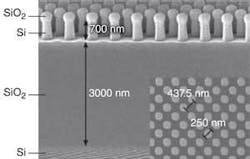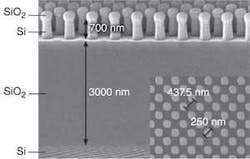Silicon rods demonstrate supercollimation in the infrared
Supercollimation, the propagation of light without diffraction, uses the properties of photonic crystals to transmit signals over centimeter-scale distances—ideal for integrated optical interconnects. Scientists at Massachusetts Institute of Technology (Cambridge, MA) and Wide Net Technologies (Watertown, MA) have demonstrated the first experimental supercollimation in a photonic-crystal slab composed of dielectric nanoscale rods. The researchers fabricated the silicon rods, each 125 nm in radius, 700 nm high, and spaced 437.5 nm apart, on a square silicon dioxide (SiO2) substrate, designed for a supercollimation wavelength of 1550 nm. A 3-µm-thick layer of low-index SiO2 separated the silicon rods from the underlying substrate to achieve index guiding.
The group directed transverse-magnetic polarized light from a tunable laser into the supercollimator sample through a single-mode fiber with a 2.5 µm spot size at the top facet of the lattice. Scattered light emerged from the side of the slab at 1550 nm for optimally fabricated rods, and traveled distances of up to 1000 lattice periods, or hundreds of microns. The rods as supercollimators therefore exhibit an increase of six times the sensitivity of similar air-hole supercollimators, indicating their suitability in optical sensing. Contact Ta-Ming Shih at [email protected].

